The Impact of Climate Change on Urban Thermal Environment Dynamics
Abstract
:1. Introduction
2. Materials and Methods
2.1. Study Area
2.2. Seasonal SUHI Characteristics
2.3. Seasonal UHI Characteristics
2.4. UHI Modeling
2.5. Modeling Limitations
3. Results
3.1. The Seasonal SUHI Intensity Footprint
3.2. SUHI Intensity and Land Use
3.3. UHI Seasonal Dynamics
3.4. The Summer UHI Model
4. Discussion
Author Contributions
Funding
Institutional Review Board Statement
Informed Consent Statement
Data Availability Statement
Conflicts of Interest
References
- United Nations. Available online: https://population.un.org/wup/Download/ (accessed on 15 February 2021).
- Wang, W.; Liu, K.; Tang, R.; Wang, S. Remote sensing image-based analysis of the urban heat island effect in Shenzhen, China. Phys. Chem. Earth 2019, 168–175. [Google Scholar] [CrossRef]
- Rizwan, A.M.; Dennis, L.Y.; Liu, C. A review on the generation, determination and mitigation of urban heat Island. J. Environ. Sci. 2008, 120–128. [Google Scholar] [CrossRef]
- Hinkel, K.M.; Nelson, F.E.; Klene, A.E.; Bell, J.H. The urban heat island in winter at Barrow. Int. J. Climatol. 2003, 23, 1889–1905. [Google Scholar] [CrossRef] [Green Version]
- Yang, L.; Qian, F.; Song, D.-X.; Zheng, K.-J. Research on urban heat-island effect. Procedia Eng. 2016, 11–18. [Google Scholar] [CrossRef]
- Tam, B.Y.; Gough, W.A.; Mohsin, T. The impact of urbanization and the urban heat island effect on day to day temperature variation. Urban Clim. 2015, 1–10. [Google Scholar] [CrossRef]
- Sobrino, J.A.; Irakulis, I. A Methodology for comparing the surface urban heat island in selected urban agglomerations Around the world from Sentinel-3 SLSTR data. Remote Sens. 2020, 12, 2025. [Google Scholar] [CrossRef]
- Parsons, K. Human Thermal Environments; CRC Press: Boca Raton, FL, USA, 2014; p. 323. [Google Scholar]
- Manoli, G.; Fatichi, S.; Schläpfer, M.; Kailiang, Y.; Crowther, T.W.; Meili, N.; Bou-Zeid, E. Magnitude of urban heat islands largely explained by climate and population. Nature 2019, 55–60. [Google Scholar] [CrossRef] [PubMed]
- Rogan, J.; Ziemer, M.; Martin, D.; Ratick, S.; Cuba, N.; DeLauer, V. The impactof tree cover loss on land surface temperature: A case study of central Massachusettsusing Landsat thematic mapper thermal data. Appl. Geogr. 2013, 45, 49–57. [Google Scholar] [CrossRef]
- Zhang, H.; Qi, Z.F.; Ye, X.Y.; Cai, Y.B.; Ma, W.C.; Chen, M.N. Analysis of landuse/land cover change, population shift, and their effects on spatiotemporalpatterns of urban heat islands in metropolitan Shanghai, China. Appl. Geogr. 2013, 44, 121–133. [Google Scholar] [CrossRef]
- Al-Hatab, M.; Samir, A.; Taha, L. Monitoring and assessment ofurban heat islands over the southern region of Cairo governoate, Eqypy. Egypt. J. Remote. Sens. Space Sci. 2018, 21, 311–323. [Google Scholar] [CrossRef]
- Evola, G.; Gagliano, A.; Fichera, A.; Marletta, L.; Martinico, F.; Nocera, F.; Pagano, A. UHI effects and strategies to improve outdoor thermalcomfort in dense and old neighborhoods. Energy Procedia 2017, 134, 629–701. [Google Scholar] [CrossRef]
- Balazs, B.; Unger, J.; Gal, T.; Sümeghy, Z.; Geiger, J.; Szegedi, S. Simulation of the mean urban heat island using 2D surface parameters:empirical modelling, verification and extension. Meteorol. Appl. 2009, 16, 275–287. [Google Scholar] [CrossRef]
- Ivajnšič, D.; Kaligarič, M.; Žiberna, I. Geographically weighted regression of the urban heat island of a small City. Appl. Geogr. 2014, 53, 341–353. [Google Scholar] [CrossRef]
- Ivajnšič, D.; Žiberna, I. The effect of weather patterns on winter small city UHIs. Meteorol. Appl. 2018, 1–9. [Google Scholar] [CrossRef]
- Bechtel, B.; Panagiotis, S.; Voogt, J.; Wenfeng, Z. Seasonal surface urban heat island analysis. In Proceedings of the Joint Urban Remote Sensing Event (JURSE), Vannes, France, 22–24 May 2019. [Google Scholar]
- Pongrácz, R.; Bartholy, J.; Dezső, Z. Application of remotely sensed thermal information to urban climatology of central European cities. Phys. Chem. Earth 2010, 35, 95–99. [Google Scholar] [CrossRef]
- Zhou, B.; Lauwaet, D.; Hooyberghs, H.; De Ridder, K.; Kropp, J.P.; Rybski, D. Assesing seasonality in the surface urban heat islan of London. J. Appl. Meteorol. Climatol. 2016, 55, 493–505. [Google Scholar] [CrossRef] [Green Version]
- Nakamura, Y.; Shigeta, Y.; Watarai, Y. Seasonal variations of the urban heat island in Kumagaya, Japan. Geogr. Rev. Jpn. Ser. 2018, 91, 29–39. [Google Scholar] [CrossRef]
- SURS. Available online: https://www.stat.si/statweb (accessed on 15 July 2021).
- Žiberna, I.; Ivajnšič, D. Vročinski valovi v Mariboru v obdobju 1961–2018. Rev. Za Geogr. 2018, 13, 73–90. [Google Scholar]
- EarthExploler. Available online: https://earthexplorer.usgs.gov (accessed on 30 April 2021).
- Eastman, J.R. TerrSet: Geospatial Monitoring and Modeling Software. Available online: https://clarklabs.org/terrset/ (accessed on 1 February 2021).
- Urban atlas Copernicus Land Monitoring Service. Available online: https://land.copernicus.eu/local/urban-atlas (accessed on 12 June 2021).
- Oke, T.R.; Fuggle, R.F. Comparison of urban/rural counter and net radiation at night. Bound. -Layer Meteorol. 1972, 3, 290–308. [Google Scholar] [CrossRef]
- ESRI (Environmental Systems Resource Institute). ArcGIS Desktop: Release 10.8; ESRI: Redlands, USA, 202. Available online: https://www.esri.com/en-us/home (accessed on 1 February 2021).
- Agencija RS za okolje. Available online: http://gis.arso.gov.si/evode/profile.aspx?id=atlas_voda_Lidar@Arso&culture=en-US (accessed on 10 July 2021).
- Copernicus Open Access Hub. Available online: https://scihub.copernicus.eu/dhus/#/home (accessed on 9 December 2020).
- MKGP, RS. Available online: https://rkg.gov.si/vstop/ (accessed on 10 June 2021).
- GURS. Available online: https://www.e-prostor.gov.si/ (accessed on 10 June 2021).
- Karger, D.N.; Conrad, O.; Böhner, J.; Kawohl, T.; Kreft, H.; Soria-Auza, R.W.; Zimmermann, N.E.; Linder, P.; Kessler, M. Climatologies at high resolution for the earth land surface areas. Sci. Data 2017, 4, 1–20. [Google Scholar] [CrossRef] [Green Version]
- Hastie, T.; Tibshirani, R. Generalized additive models: Some applications. J. Am. Stat. Assoc. 1987, 82, 371–386. [Google Scholar] [CrossRef]
- Hastie, T.; Tibshirani, R. Generalized Additive Models; Chapman and Hall/CRC: London, UK, 1990. [Google Scholar]
- James, G.; Witten, D.; Hastie, T.; Tibshirani, R. An Introduction to Statistical Learning; Springer: New York, NY, USA, 2013; p. 112. [Google Scholar]
- Gaur, A.; Eichenbaum, M.K.; Simonovic, S.P. Analysis and modelling of surface urban heat island in 20 Canadian cities under climate and land-cover change. J. Environ. Manag. 2018, 206, 145–157. [Google Scholar] [CrossRef]
- R Core Team. The R Project for Statistical Computing; R Development Core Team: Vienna, Austria, 1996; Available online: https://www.r-project.org/ (accessed on 15 June 2020).
- Wood, S.N. Generalized Additive Models an Introduction with R, 2nd ed.; Chapman and Hall/CRC: Boca Raton, FL, USA, 2017; pp. 50–52. [Google Scholar] [CrossRef]
- Wood, S.N. Generalized Additive Models: An Introduction with R.; Chapman and Hall/CRC: London, UK, 2006. [Google Scholar]
- Ravindra, K.; Rattan, P.; Mor, S.; Aggarwal, A.N. Generalized additive models: Building evidence of air pollution, climate change and human health. Environ. Int. 2019, 132, 104987. [Google Scholar] [CrossRef] [PubMed]
- Fox, J.; Bouchet-Valat, M. Rcmdr: R Commander. R package version 2.7-1. 2020. Available online: https://cran.r-project.org/web/packages/Rcmdr/index.html (accessed on 25 May 2021).
- Žiberna, I. Spremembe rabe tal v občinah ob Dravi v Sloveniji v obdobju 2000–2018. Ekon. I Ekohist. Časopis Za Gospod. Povij. I Povij. Okoliša 2019, 15, 55–65. [Google Scholar]
- Žiberna, I.; Konečnik Kotnik, E. Spremembe rabe tal v Sloveniji med letoma 2000 in 2020. Geogr. V Šoli. 2020, 28, 6–17. [Google Scholar]
- Horvat, U.; Žiberna, I. The correlation between demographic development and land-use changes in Slovenia. Acta Geogr. Slov. 2020, 60, 33–55. [Google Scholar] [CrossRef]
- Donša, D.; Kaligarič, M.; Škornik, S.; Pipenbaher, N.; Grujić, J.V.; Davidović, D.; Žiberna, I.; Ivajnšič, D. Dinamika sprememb rabe prostora pod vplivom različnih gospodarskih sistemov: Primer uporabe podatkov satelita LANDSAT. Rev. Za Geogr. 2020, 15, 59–73. [Google Scholar]
- Horvat, U. Prebivalstvo Maribora: Razvoj in Demografske Značilnosti; Univerzitetna Založba Univerze: Maribor, Slovenija, 2019; p. 156. [Google Scholar]
- Xu, X.; Cai, H.; Qiao, Z.; Wang, L.; Jin, C.; Ge, Y.; Wu, F. Impacts of park landscape structure on thermal environment using quickbird and landsat images. Chin. Geogr. Sci. 2017, 818–826. [Google Scholar] [CrossRef]
- Mirza, M.Q. Climate change and extreme weather events: Can developing countries adapt? Clim. Policy 2003, 233–248. [Google Scholar] [CrossRef]
- Zittis, G.; Hadjinicolaou, P.; Fnais, M.; Lelieveld, J. Projected changes in heat wave characteristics in the eastern Mediterranean and the middleeast. Reg. Environ. Chang. 2016, 16, 1863–1876. [Google Scholar] [CrossRef]
- Pogačcar, T.; Zalar, M.; Kajfež-Bogataj, L. Vročinski valovi v povezavi z zdravjem in produktivnostjo. Univers. J. Math. 2016, 30, 151–160. [Google Scholar]
- Žiberna, I. Trendi vodne bilance v severovzhodni Sloveniji v obdobju 1961–2016. In Geografija Podravja, Prostori; Drozg, V., Horvat, U., Konečnik Kotnik, E., Eds.; Univerzitetna Založba Univerze v Mariboru: Maribor, Slovenia, 2017; pp. 23–45. [Google Scholar]
- Arnfield, A.J. Two decades of urban climate research: A review of turbulence, exchanges of energy and water, and the urban heat island. Int. J. Climatol. 2003, 23, 1–26. [Google Scholar] [CrossRef]
- Buyantuyev, A.; Wu, J. Urban heat islands and landscape heterogeneity: Linking spatiotemporal variations in surface temperatures to land-cover and socioeconomic patterns. Landsc. Ecol. 2010, 25, 17–33. [Google Scholar] [CrossRef]
- Oshan, T.M.; Li, Z.; Kang, W.; Wolf, L.J.; Fotheringham, A.S. “mgwr: A python implementation of multiscale geographically weighted regression for investigating process spatial heterogeneity and scale” ISPRS international. J. Geo-Inf. 2019, 8, 269. [Google Scholar] [CrossRef] [Green Version]
- Nakaya, T.; Charlton, M.; Yao, J.; Fotheringham, A.S. GWR4.09 User Manual: Windows Application for Geographically Weighted Regression Modelling. 2016. Available online: http://manualslist.info/pdf/gwr409-user-manual-geodacenterorg.html (accessed on 14 June 2021).
- Ivajnšič, D.; Donša, D. Intenzivnost podnebnih sprememb na območjih Natura 2000 v Sloveniji. Rev. Za Geogr. 2018, 13, 59–71. [Google Scholar]
- Bertalanič, R.; Dolinar, M.; Draksler, A.; Honzak, L.; Kobold, M.; Kozjek, K.; Lokošek, N.; Medved, A.; Vertačnik, G.; Vlahović, Ž.; et al. 2018. Ocena Podnebnih Sprememb v Sloveniji do Konca 21. Stoletja. Sintezno Poročilo—Prvi del. Ministrstvo za Okolje in Prostor. Ljubljana. Available online: https://meteo.arso.gov.si/uploads/probase/www/climate/text/sl/publications/OPS21_Porocilo.pdf (accessed on 9 May 2021).
- Melik, A. Geografski Opis; Ljubljana, 1st ed.; Slovenske Matica: Ljubljana, Slovenia, 1963. [Google Scholar]
- United States Government. Available online: https://www.epa.gov/heatislands/climate-change-and-heat-islands (accessed on 10 May 2021).
- U.S. Environmental Protection Agency (EPA). Climate Change Indicators in the United States, 4th ed.; EPA 430-R-16-004; EPA: Washington, DC, USA, 2016. Available online: www.epa.gov/climate-indicators (accessed on 20 May 2020).
- Wilbanks, T.J.V.; Bhatt, D.E.; Bilello, S.R.; Bull, J.; Ekmann, W.C.; Horak, Y.J.; Huang, M.D.; Levine, M.J.; Sale, D.K.; Schmalzer, M.J. Effects of Climate Change on Energy Production and Use in the United States. A Report by the U.S. Climate Change Science Program and the Subcommittee on Global Change Research; Department of Energy, Office of Biological & Environmental Research: Washington, DC, USA, 2021. Available online: https://www.globalchange.gov/browse/reports/sap-45-effects-climate-change-energy-production-and-use-united-states (accessed on 15 May 2021).
- United States Global Change Research Program (USGCRP). The Impacts of Climate Change on Human Health in the United States: A Scientific Assessment; Crimmins, A., Balbus, J., Gamble, J.L., Beard, C.B., Bell, J.E., Dodgen, D., Eisen, R.J., Fann, N., Hawkins, M.D., Herring, S.C., et al., Eds.; U.S. Global Change Research Program: Washington, DC, USA, 2016; p. 312. Available online: https://health2016.globalchange.gov/ (accessed on 15 May 2021).
- Choi, H.A.; Lee, W.K.; Byun, W.H. Determining the effect of green spaces on urban heat distribution using satellite imagery. Asian J. Atmos. Environ. 2012, 6, 127–135. [Google Scholar] [CrossRef]
- Spronken-Smith, R.A.; Oke, T.R. The thermal regime of urban parks in two cities with different summer climates. Int. J. Remote Sens. 1998, 19, 2085–2104. [Google Scholar] [CrossRef]
- Upmanis, H.; Eliasson, I.; Lindqvist, S. The influence of green areas on nocturnal temperatures in a high latitude city (Göteborg, Sweden). Int. J. Climatol. 1998, 18, 681–700. [Google Scholar] [CrossRef]
- Feyisa, G.L.; Dons, K.; Meilby, H. Efficiency of parks in mitigating urban heat island effect: An example from Addis Ababa. Landsc. Urban Plan. 2014, 123, 87–95. [Google Scholar] [CrossRef]
- Global Climate Change. Available online: https://climate.nasa.gov/vital-signs/carbon-dioxide/ (accessed on 10 May 2021).
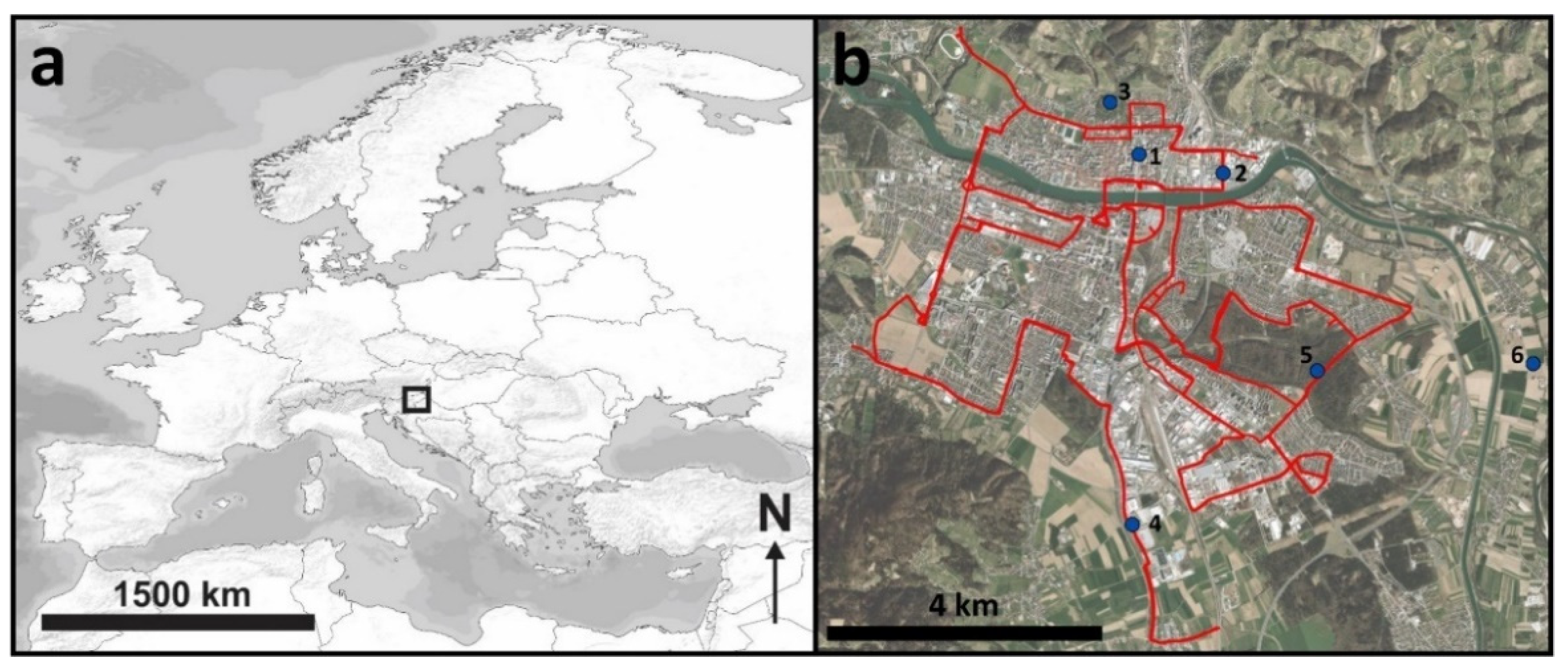
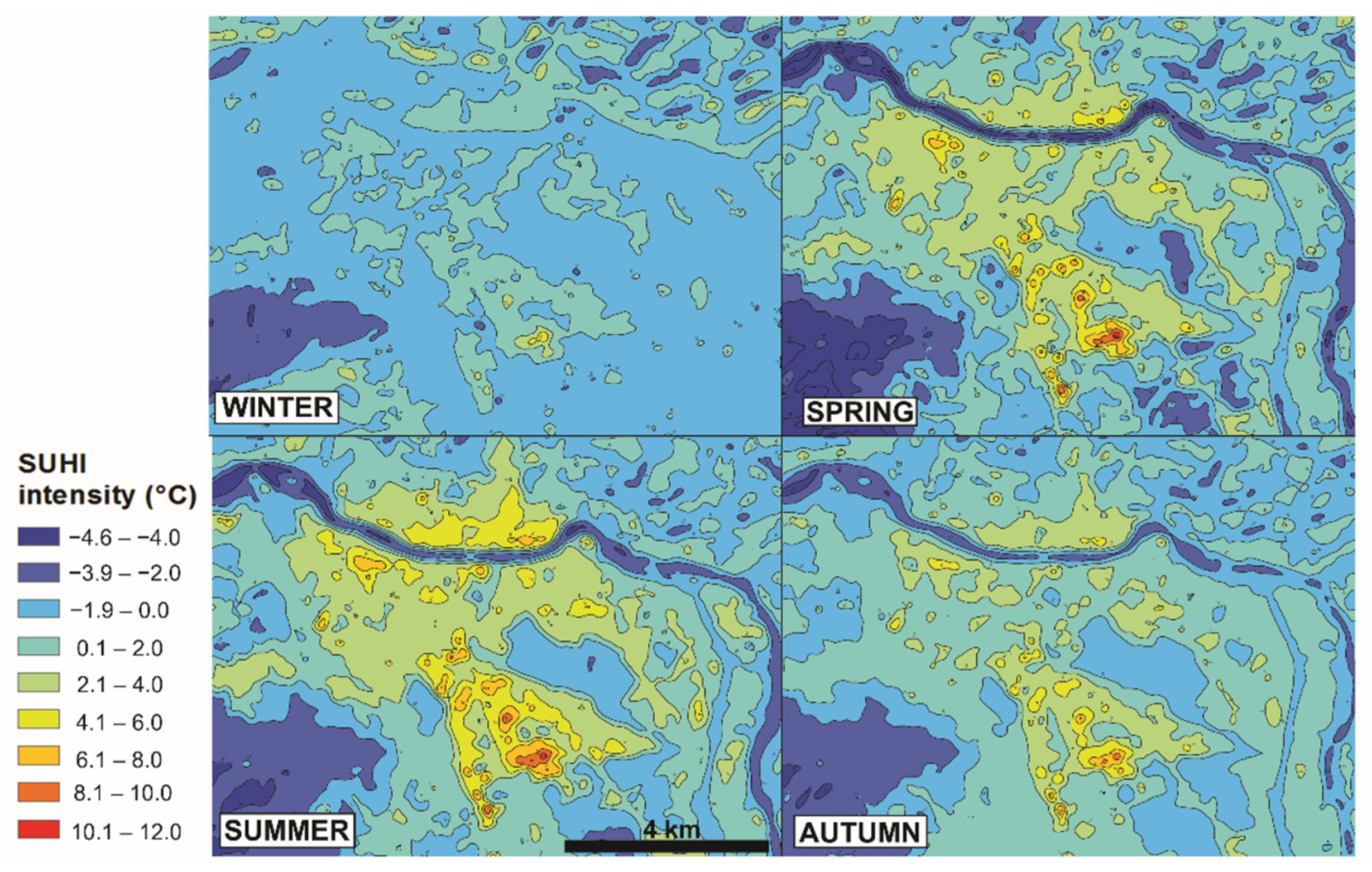
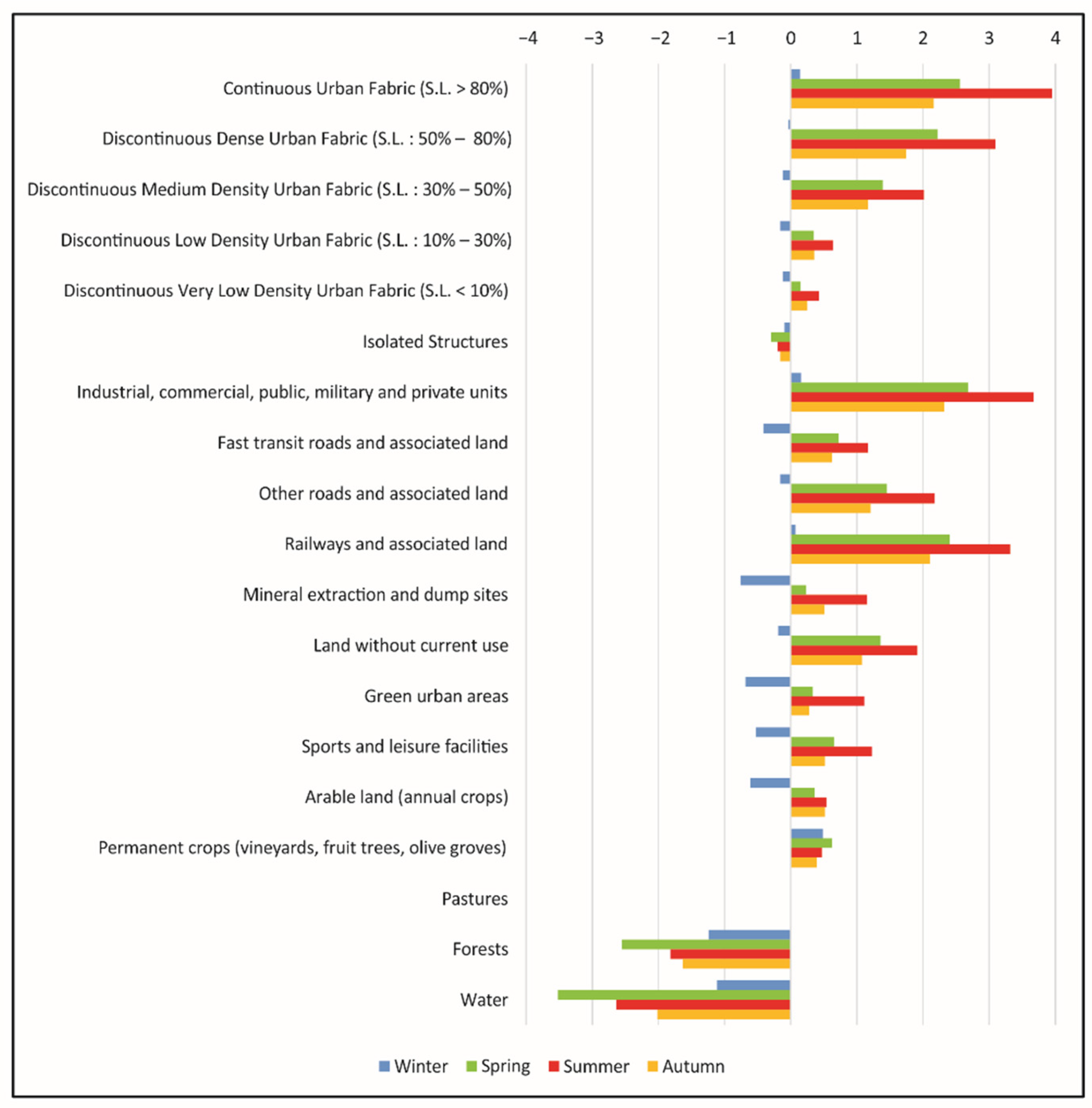
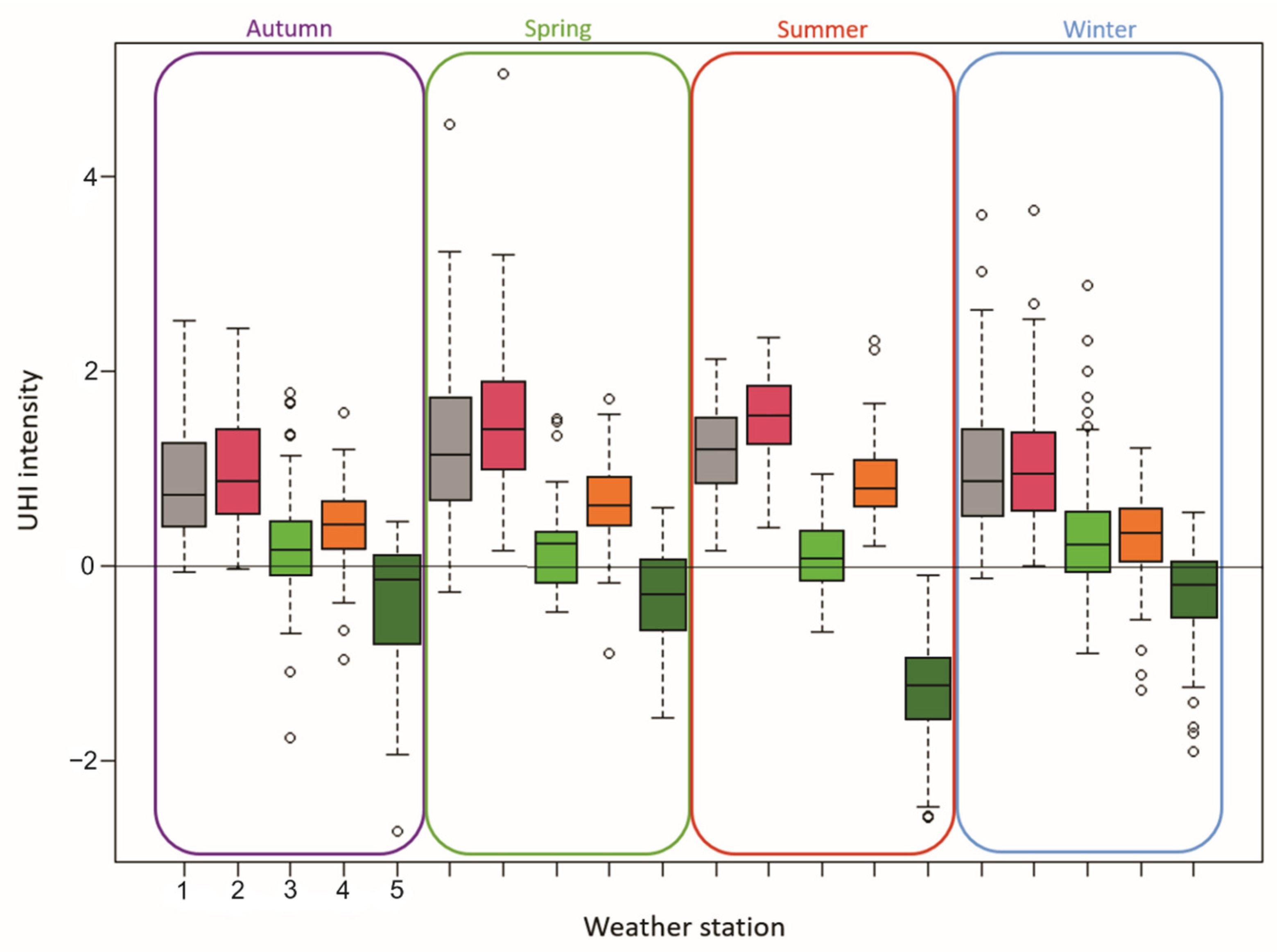
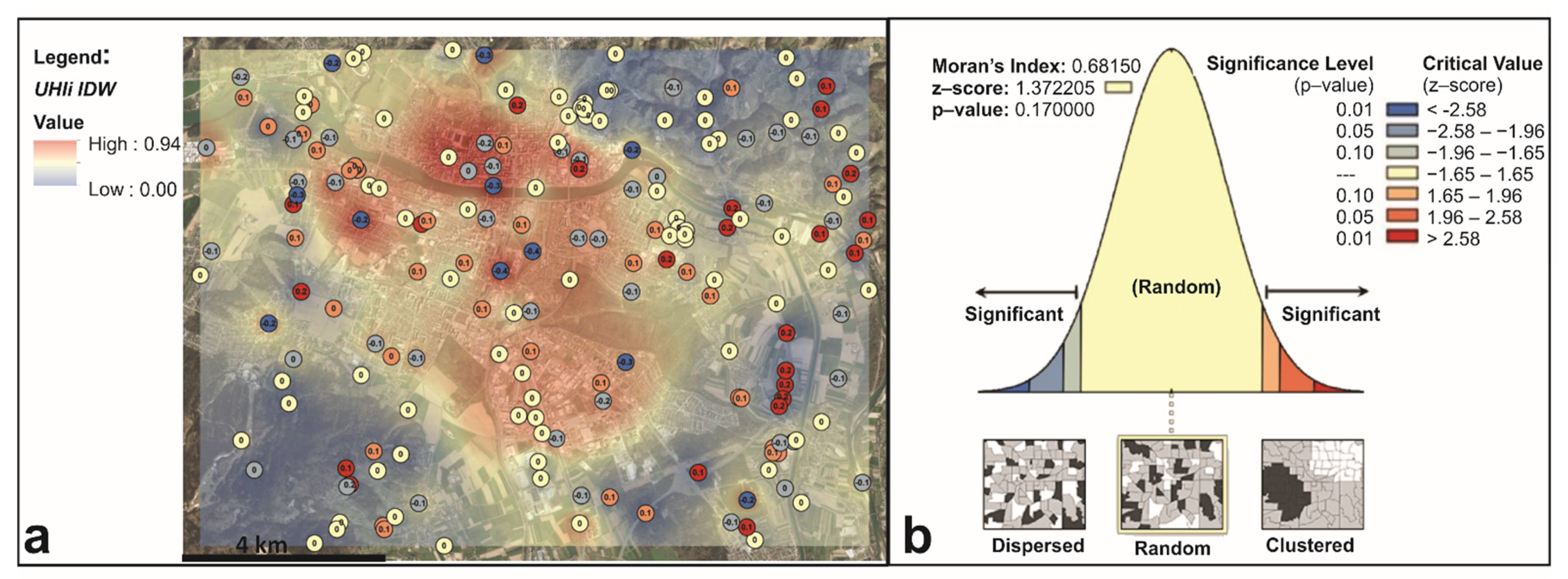
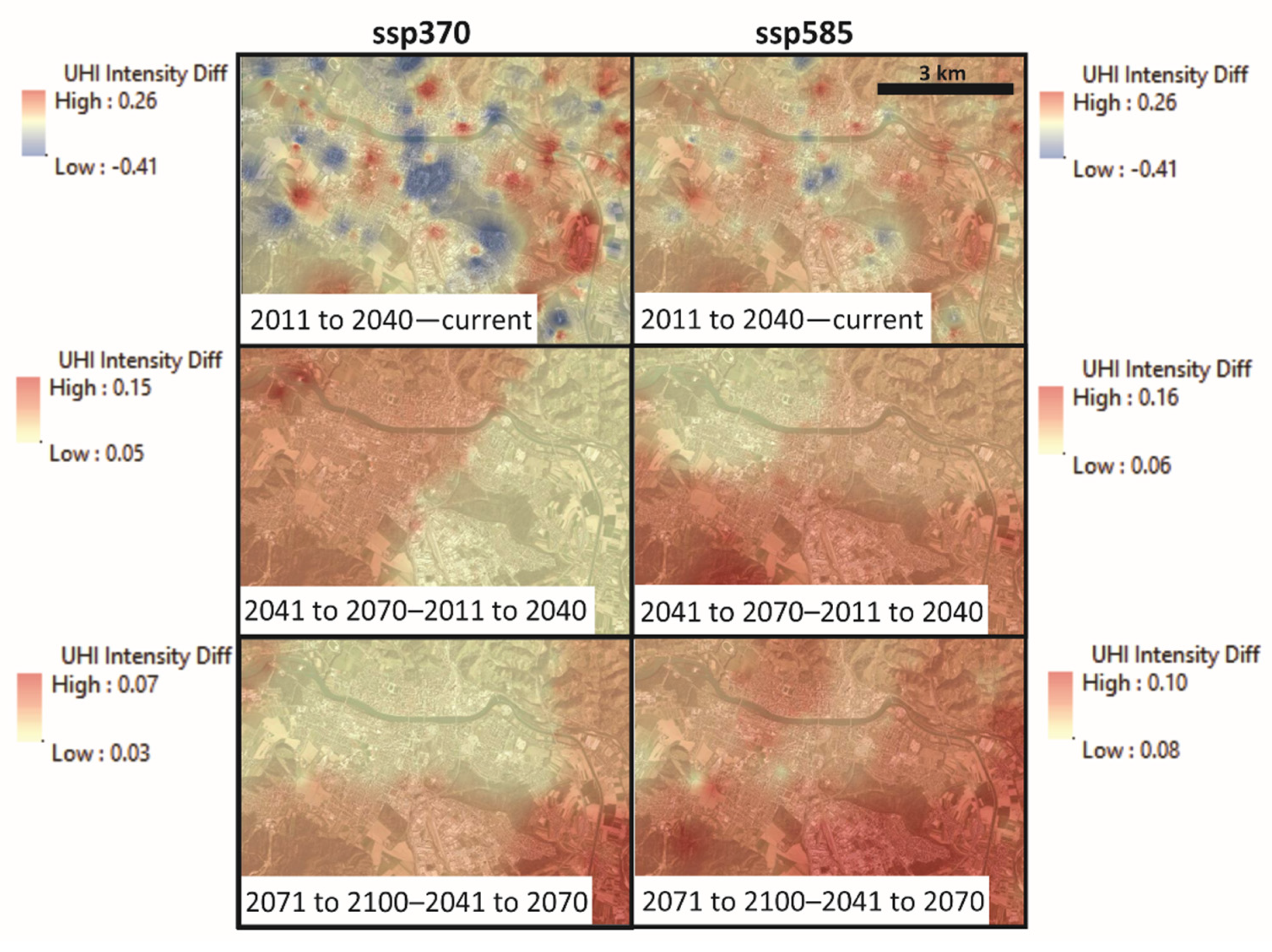
| Variable | bv | d2wb | NDVI | sness | SUHIi | tas_summer | hvegv |
|---|---|---|---|---|---|---|---|
| bv | 1 | 0.13 | −0.26 | 0.01 | 0.4 | 0.09 | 0.32 |
| d2wb | 0.13 | 1 | 0.22 | 0.12 | 0.3 | −0.11 | 0.12 |
| NDVI | −0.26 | 0.22 | 1 | 0.36 | −0.3 | −0.39 | −0.03 |
| sness | 0.01 | 0.12 | 0.36 | 1 | 0.25 | −0.08 | 0.02 |
| SUHIi | 0.4 | 0.3 | −0.3 | 0.25 | 1 | 0.42 | 0.11 |
| tas_summer | 0.09 | −0.11 | −0.39 | −0.08 | 0.42 | 1 | 0.08 |
| hvegv | 0.32 | 0.12 | −0.03 | 0.02 | 0.11 | 0.08 | 1 |
| Model: UHIi ~ s(SUHIi) + s(sness) + s(NDVI) + s(d2wb) + s(bv) + s(hvegv) +s(tas_summer) Parametric coefficients: | ||||
| Estimate | Std. Error | tvalue | Pr (>|t|) | |
| (Intercept) | 0.356884 | 0.008359 | 42.7 | <2 × 10−16 *** |
| Approximate significance of smooth terms: | ||||
| edf | Ref. df | F | p-value | |
| s(SUHIi) | 5.547 | 6.736 | 29.566 | <2 × 10−16 *** |
| s(sness) | 7.782 | 8.545 | 3.938 | <2 × 10−16 *** |
| s(NDVI) | 7.029 | 7.855 | 7.058 | <2 × 10−16 *** |
| s(d2wb) | 2.506 | 3.123 | 5.863 | 0.000707 *** |
| s(bv) | 1 | 1 | 18.101 | 0.0000356 *** |
| s(hvegv) | 3.301 | 3.703 | 20.386 | <2 × 10−16 *** |
| s(tas_summer) | 1 | 1 | 0.661 | 0.41751 |
| R-sq. (adj) = 0.793 Deviance explained = 82.4% V = 0.015682 Scale est. = 0.013275 n = 190 | ||||
| Model 1: UHIi ~ SUHIi + sness + NDVI + d2wb + bv + hvegv + tas_summer Model 2: UHIi ~ s(SUHIi) + s(sness) + s(NDVI) + s(d2wb) + s(bv) + s(hvegv) + s(tas_summer) | |||||
| Residual | Df | Residual Deviance | Df Deviance | Pr (>Chi) | |
| Model 1 | 182 | 5.8691 | |||
| Model 2 | 160.83 | 2.135 | 21.166 | 3.734 | <2.2 × 10−16 *** |
Publisher’s Note: MDPI stays neutral with regard to jurisdictional claims in published maps and institutional affiliations. |
© 2021 by the authors. Licensee MDPI, Basel, Switzerland. This article is an open access article distributed under the terms and conditions of the Creative Commons Attribution (CC BY) license (https://creativecommons.org/licenses/by/4.0/).
Share and Cite
Žiberna, I.; Pipenbaher, N.; Donša, D.; Škornik, S.; Kaligarič, M.; Bogataj, L.K.; Črepinšek, Z.; Grujić, V.J.; Ivajnšič, D. The Impact of Climate Change on Urban Thermal Environment Dynamics. Atmosphere 2021, 12, 1159. https://doi.org/10.3390/atmos12091159
Žiberna I, Pipenbaher N, Donša D, Škornik S, Kaligarič M, Bogataj LK, Črepinšek Z, Grujić VJ, Ivajnšič D. The Impact of Climate Change on Urban Thermal Environment Dynamics. Atmosphere. 2021; 12(9):1159. https://doi.org/10.3390/atmos12091159
Chicago/Turabian StyleŽiberna, Igor, Nataša Pipenbaher, Daša Donša, Sonja Škornik, Mitja Kaligarič, Lučka Kajfež Bogataj, Zalika Črepinšek, Veno Jaša Grujić, and Danijel Ivajnšič. 2021. "The Impact of Climate Change on Urban Thermal Environment Dynamics" Atmosphere 12, no. 9: 1159. https://doi.org/10.3390/atmos12091159
APA StyleŽiberna, I., Pipenbaher, N., Donša, D., Škornik, S., Kaligarič, M., Bogataj, L. K., Črepinšek, Z., Grujić, V. J., & Ivajnšič, D. (2021). The Impact of Climate Change on Urban Thermal Environment Dynamics. Atmosphere, 12(9), 1159. https://doi.org/10.3390/atmos12091159








